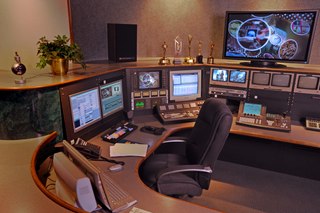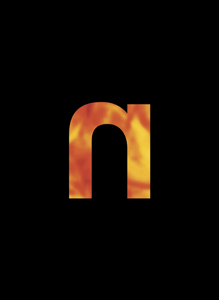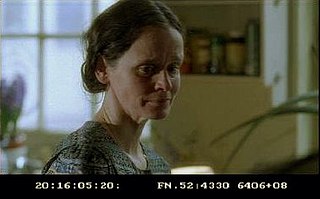Related Research Articles

Non-linear editing is a form of offline editing for audio, video, and image editing. In offline editing, the original content is not modified in the course of editing. In non-linear editing, edits are specified and modified by specialized software. A pointer-based playlist, effectively an edit decision list (EDL), for video and audio, or a directed acyclic graph for still images, is used to keep track of edits. Each time the edited audio, video, or image is rendered, played back, or accessed, it is reconstructed from the original source and the specified editing steps. Although this process is more computationally intensive than directly modifying the original content, changing the edits themselves can be almost instantaneous, and it prevents further generation loss as the audio, video, or image is edited.

Telecine is the process of transferring film into video and is performed in a color suite. The term is also used to refer to the equipment used in the post-production process. Telecine enables a motion picture, captured originally on film stock, to be viewed with standard video equipment, such as television sets, video cassette recorders (VCR), DVD, Blu-ray Disc or computers. Initially, this allowed television broadcasters to produce programmes using film, usually 16mm stock, but transmit them in the same format, and quality, as other forms of television production. Furthermore, telecine allows film producers, television producers and film distributors working in the film industry to release their productions on video and allows producers to use video production equipment to complete their filmmaking projects. Within the film industry, it is also referred to as a TK, because TC is already used to designate timecode. Motion picture film scanners are similar to telecines.

Color grading is the process of improving the appearance of an image for presentation in different environments on different devices. Various attributes of an image such as contrast, color, saturation, detail, black level, and white point may be enhanced whether for motion pictures, videos, or still images. Color grading and color correction are often used synonymously as terms for this process and can include the generation of artistic color effects through creative blending and compositing of different images. Color grading is generally now performed in a digital process either in a controlled environment such as a color suite, or in any location where a computer can be used in dim lighting.

A camcorder is a self-contained portable electronic device with video and recording as its primary function. It is typically equipped with an articulating screen mounted on the left side, a belt to facilitate holding on the right side, hot-swappable battery facing towards the user, hot-swappable recording media, and an internally contained quiet optical zoom lens.

Broken is a 1993 horror musical short film and long-form music video filmed and directed by Peter Christopherson. It is based on an idea by Trent Reznor, founder of industrial rock band Nine Inch Nails, and is a companion piece to the 1992 Nine Inch Nails EP Broken.
In video technology, 24p refers to a video format that operates at 24 frames per second frame rate with progressive scanning. Originally, 24p was used in the non-linear editing of film-originated material. Today, 24p formats are being increasingly used for aesthetic reasons in image acquisition, delivering film-like motion characteristics. Some vendors advertise 24p products as a cheaper alternative to film acquisition.
Deinterlacing is the process of converting interlaced video into a non-interlaced or progressive form. Interlaced video signals are commonly found in analog television, digital television (HDTV) when in the 1080i format, some DVD titles, and a smaller number of Blu-ray discs.

HDV is a format for recording of high-definition video on DV cassette tape. The format was originally developed by JVC and supported by Sony, Canon, and Sharp. The four companies formed the HDV Consortium in September 2003.
A telesync (TS) is a bootleg recording of a film recorded in a movie theater, often filmed using a professional camera on a tripod in the projection booth. The audio of a TS is captured with a direct connection to the sound source. Sometimes the bootlegger will tape or conceal wireless microphones close to the speakers for better sound quality. A TS can be considered a higher quality type of cam, that has the potential of better-quality audio and video.
Film-out is the process in the computer graphics, video production and filmmaking disciplines of transferring images or animation from videotape or digital files to a traditional film print. "Film-out" is a broad term that encompasses the conversion of frame rates, color correction, as well as the actual printing, also called scannior recording.

A workprint is a rough version of a motion picture, used by the film editor(s) during the editing process. Such copies generally contain original recorded sound that will later be re-dubbed, stock footage as placeholders for missing shots or special effects, and animation tests for in-production animated shots or sequences.
In filmmaking, dailies are the raw, unedited footage shot during the making of a motion picture. The term comes from when movies were all shot on film because usually at the end of each day, the footage was developed, synced to sound, and printed on film in a batch for viewing the next day by the director, selected actors, and film crew members. After the advent of digital filmmaking, "dailies" were available instantly after the take and the review process was no longer tied to the overnight processing of film and became more asynchronous. Now some reviewing may be done at the shoot, even on location, and raw footage may be immediately sent electronically to anyone in the world who needs to review the takes. For example, a director can review takes from a second unit while the crew is still on location or producers can get timely updates while travelling. Dailies serve as an indication of how the filming and the actors' performances are progressing. The term was also used to describe film dailies as "the first positive prints made by the laboratory from the negative photographed on the previous day".

Digital cinematography is the process of capturing (recording) a motion picture using digital image sensors rather than through film stock. As digital technology has improved in recent years, this practice has become dominant. Since the mid-2010s, most movies across the world are captured as well as distributed digitally.

A motion picture film scanner is a device used in digital filmmaking to scan original film for storage as high-resolution digital intermediate files.
A cam is a bootleg recording of a film. Generally unlike the more common DVD rip or screener recording methods which involve the duplication of officially distributed media, cam versions are original clandestine recordings made in movie theaters.
Pirated movie release types are the different types of pirated movies and television series that end up on the Internet. They vary wildly in rarity and quality due to the different sources and methods used for acquiring the video content, in addition to encoding formats. Pirated movie releases may be derived from cams, which have distinctly low quality; screener and workprint discs or digital distribution copies (DDC), telecine copies from analog reels, video on demand (VOD) or TV recordings, and DVD and Blu-ray rips. They are seen in P2P networks, pirated websites and video sharing websites such as YouTube and Dailymotion.
R5, in the film business, is a DVD of a movie sold in Russia very soon after the first screening in cinema, at reduced wholesale prices. It is made with a telecine machine from an analog source and is typically of a lower quality than other retail releases.

A film chain or film island is a television – professional video camera with one or more projectors aligned into the photographic lens of the camera. With two or more projectors a system of front-surface mirrors that can pop-up are used in a multiplexer. These mirrors switch different projectors into the camera lens. The camera could be fed live to air for broadcasting through a vision mixer or recorded to a VTR for post-production or later broadcast. In most TV use this has been replaced by a telecine.
A color suite is the control room for color grading video in a post-production environment.
Spirit DataCine is a telecine and a motion picture film scanner. This device is able to transfer 16mm and 35mm motion picture film to NTSC or PAL television standards or one of many High-definition television standards. With the data transfer option a Spirit DataCine can output DPX data files. The image pick up device is a solid state charge-coupled device. This eliminated the need for glass vacuum tube CRTs used on older telecines. The units can transfer negative film, primetime, intermediate film and print film, stock. One option is a Super 8 gate for the transfer of Super 8 mm film. With a sound pick up option, optical 16mm and 35mm sound can be reproduced, also 16mm magnetic strip sound. The unit can operate stand alone or be controlled by a scene by scene color corrector. Ken Burns created The Civil War, a short documentary film included in the DVD release, on how he used the Spirit DataCine to transfer and remaster this film. The operator of the unit is called a Colorist or Colorist Assistant. The Spirit DataCine has become the standard for high-end real-time film transfer and scanning. Over 370 units are used in post production facilities around the world. Most current film productions are transferred on Spirit DataCines for Television, Digital television, Cable television, Satellite television, Direct-to-video, DVD, Blu-ray Disc, pay-per-view, In-flight entertainment, Stock footage, Dailies, Film preservation, digital intermediate and digital cinema. The Spirit DataCine is made by DFT Digital Film Technology GmbH in Darmstadt, Germany.
References
- ↑ "AfterDawn.com Glossary - Telecine".
- 1 2 Christopher George. "What are the different types of Piracy?". Archived from the original on 2012-03-01.
- ↑ Craig, Paul; Honick, Ron (April 2005). "Chapter 8: The Piracy Scene". In Burnett, Mark (ed.). Software Piracy Exposed - Secrets from the Dark Side Revealed. United States of America: Syngress Publishing. pp. 165–166. doi:10.1016/B978-193226698-6/50033-7. ISBN 1-932266-98-4.
A telecine is the result of capturing each frame of footage directly from the film reel. This is achieved by projecting each frame of the film onto a charge coupled device (CCD). CCDs capture and record the projected video, giving Telecines a substantial increase in picture quality over both telesync and CAM. Although telecines are essentially an analog film capture, the film quality is close to that of a DVD. If a pirate has the technology and the time to produce a telecine, chances are it will pass as a DVD copy on the black market. Telecine audio comes directly from the mixing desk, which makes the telecine version of a film hard to distinguish from the real DVD. However, creating a telecine can take days of work. CCDs operate slowly, and a standard movie will take six to seven hours to capture. After capturing the video, the sound must be included and synced with each frame of video. Because they must be re-mastered, cleaned up, and packed, the full process of creating a telecine can take three to four days.
- ↑ "VCDQuality: Terms". Archived from the original on March 4, 2010. Lists recent video releases in the warez scene.
- ↑ "OlryDB.com". Archived from the original on March 2, 2012. Predb showing the usage of the TC tag in the scene.